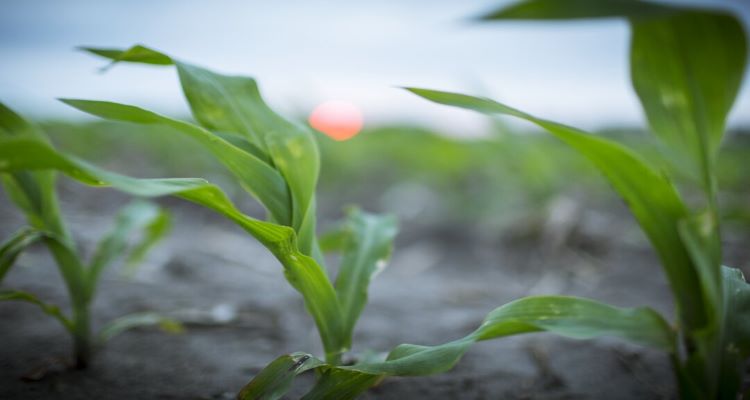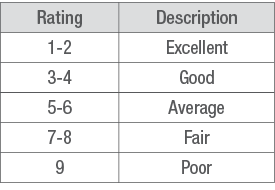November 17, 2022

Product ratings help seed companies position their products under the right conditions to meet the farmer’s needs, field conditions, and management practices to promote the most successful outcome.
Product rating categories include agronomic and seed characteristics, maturity, placement recommendations, growing degree unit (GDU) requirements, planting rate recommendations, and stress tolerance.
Overview of Product Ratings
All DEKALB brand corn products use the same rating scales. The general product characteristic rating scale runs from 1-9; 1 is best, 5 is average, and greater than 5 is below average (Table 1). Other characteristics have individualized ratings. Product ratings are relevant within comparisons of other DEKALB® brand corn products only; comparisons to ratings for competitors' products could be inaccurate since the rating scale between companies is not calibrated.

Corn product rating categories include agronomic and seed characteristics, maturity, placement recommendations, growing degree unit (GDU) requirements, recommended planting rates, herbicide sensitivity, disease tolerance, and tolerance to abiotic stresses.
Agronomic characteristics, adaptation, and planting rate information is based on observations made during pre-commercial product testing, as well as knowledge of the background of related products used during breeding. These ratings provide essential information to farmers for on-farm positioning.
Herbicide sensitivity ratings provide the anticipated product response to the respective herbicide family. These ratings are based on observations using herbicides at and above labeled rates to simulate extreme environmental conditions, misapplication, and adverse soil pH or organic matter content. Under labeled herbicide use rates and normal environmental conditions, most products do not have sensitivity issues with most herbicide families.
Disease ratings are more difficult to generate because it is difficult to simulate disease pressure with consistent presence and severity across multiple locations for comparable evaluations. Plant pathologists artificially inoculate products with disease pathogens for evaluation. However, if conditions are not favorable for disease development each year, the incidence of disease may not be adequate for evaluation. Therefore, ratings for specific diseases are not always available for all products.
It is not common for a product to be rated excellent or good for every agronomic factor and disease tolerance rating. Farmers need to evaluate what diseases or agronomic risk factors have been important in their fields in the past as well as what factors are common to their geography and select products that tend to have stronger ratings for those factors. Not all ratings are important to every geography. For example, if Goss’s wilt tolerance were used as a selection criterion for a farmer in the eastern Corn Belt, the best product adapted for that region may not be selected.
Corn Product Ratings
Relative maturity (RM)
A relative measure of the time it takes from planting for the corn product to reach maturity. This is an estimate and actual maturity can vary based on environmental conditions and geographic location.
Growing Degree Units (GDUs)
The estimated number of GDUs needed to reach mid-pollination (flowering) and black layer (maturity). This rating can vary based on environmental conditions. This rating is especially useful when selecting a product for late planting and when GDUs remaining in the growing season may be limited.
Planting rates
The recommended planting population for each product is based on planting rate trials conducted over a wide range of environments. The general range is listed as high (H), medium-high (MH), medium (M), medium low (ML), or low (L).
Cob color
These ratings described the color of the cob that most often either red, pink, or white.
Kernel rows
Higher kernel row products are often considered to be flex-ear corn products, which can adjust ear size depending on growing conditions and tend to yield well at lower populations, but yields generally plateau at higher populations, whereas fixed-ear products (low kernel row products) generally show increased yield as seeding rate increases. These ratings range from an average of 14 to 18 kernel rows per ear. Individual ears can be found outside of this range if a plant is in an extremely high population (low kernel row count) or an extremely low population (high kernel row count) which is also influenced by the genetic makeup of the product.
Emergence
The ability of the crop to emerge quickly and uniformly under stressful conditions is rated on a scale of 1-9, with 1 being the best. Emergence ratings are especially important with an early planting date and with adverse environmental conditions during and immediately after planting.
Seedling growth
As corn products come through the breeding program each product is evaluated for seedling growth. Some corn products have demonstrated that they can grow faster under less-than-ideal growing conditions and these products have been rated at a lower number which indicates a faster seedling growth characteristic. Seedling growth is rated on a scale of 1-9, with 1 being the best.
Root strength and Stalk strength
Rated on a scale of 1-9, with 1 being the highest strength or standability.
Drought tolerance
Rated on a scale of 1-9, with 1 being the highest level of drought tolerance.
Greensnap tolerance
Rated on a scale of 1-9; products rated from 1-3 are the best choice for managing fields or environments with historic greensnap issues.
Plant height
Rated as short (S), medium short (MS), medium (M), medium tall (MT), and tall (T). This can vary with environmental conditions. Taller plants have often been considered more desirable for silage production whereas shorter plants are generally more desirable for grain production in fields prone to lodging or in fields where harvest stover needs to be minimized. Plant height can also be influenced by planting date. Later planted dates can influence a product to have a taller plant height.
Ear placement
Ear height is rated as low (L), medium low (ML), medium (M), medium high (MH), and high (H). The optimum ear height depends on preferences, growing environment, and management practices.
Staygreen
Staygreen means that the plant can maintain transpiration and photosynthesis longer into the season, when other corn products may begin to mature naturally, near the end of grain fill period, the plant’s metabolism slowly deteriorates, and the plant starts to dry down (senesce). Staygreen may lengthen the duration of the grain-fill period, thereby improving kernel set and test weight. Staygreen can also help promote improved late season standability. Staygreen can also be an important trait if the corn product is taken for silage as the better the staygreen the longer the product can stay in the correct whole plant moisture content for the improved ensiling of that product. Staygreen potential is rated on a scale of 1-9, with 1 being the best.
Harvest appearance
Rated on a scale of 1-9. This is calculated based on the plant's ability to maintain the intactness of leaves and tassel as it approaches maturity, as well as the overall appearance of the plant at maturity.
Drydown
Differences in ear and husk characteristics between corn germplasm can affect the rate of drydown, including the number, thickness, coverage, and tightness of the husk leaves along with how compact the kernels are positioned on the cob. Drydown is rated on a scale of 1-9; products with a rating of 1 have the fastest drydown
Test weight
Rated on a scale of 1-9; products with a rating of 1 have the highest average test weight. Corn products with higher vitreous (hard or flinty) endosperm tend to have higher test weights than products with floury (soft or dent) endosperm due to vitreous kernels having higher densities.
Disease tolerances
There are currently ten corn diseases that have ratings in the National Characteristic Chart. Not all products have a rating for all the diseases listed. When listed the product’s level of tolerance to diseases of concern is rated on a 1-9 scale, with 1-2 = excellent tolerance and 9 = poor or very susceptible.
Herbicide tolerances
The product’s response to different herbicide families is rated as acceptable (A): crop injury from a labeled application is unlikely, caution (C): crop injury is possible from a labeled application if the application occurs with adverse environmental conditions, and warning (W): crop injury is likely from a labeled application even with good environmental conditions. There are currently three herbicide families listed in the National Characteristic Chart.
DeKalb agronomists provide corn product recommendations based on local conditions. To find the best product for your field, go to our Seed Finder. The Seed Finder gives you agronomist-recommended seed options for your operation based on highly localized data. Local seed guides are linked to your zip code and may provide additional information for your area.
Source: DeKalb Seeds
You May Also Like




